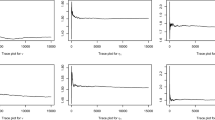Abstract
We propose a computational framework to quantify (measure) and to optimize the reliability of complex systems. The approach uses a graph representation of the system that is subject to random failures of its components (nodes and edges). Under this setting, reliability is defined as the probability of finding a path between sources and sink nodes under random component failures and we show that this measure can be computed by solving a stochastic mixed-integer program. The stochastic programming setting allows us to account for system constraints and general probability distributions to characterize failures and allows us to derive optimization formulations that identify designs of maximum reliability. We also propose a strategy to approximately solve these problems in a scalable manner by using purely continuous formulations.














Similar content being viewed by others
References
Bansal V, Perkins JD, Pistikopoulos EN (1998) Flexibility analysis and design of dynamic processes with stochastic parameters. Comput Chem Eng 22:S817–S820
Birge JR, Louveaux F (2011) Introduction to stochastic programming. Springer, Berlin
Bistouni F, Jahanshahi M (2014) Analyzing the reliability of shuffle-exchange networks using reliability block diagrams. Reliabil Eng Syst Saf 132:97–106
Dunning I, Huchette J, Lubin M (2017) Jump: a modeling language for mathematical optimization. SIAM Rev 59(2):295–320
Hsu P-L, Robbins H (1947) Complete convergence and the law of large numbers. Proc Nat Acad Sci USA 33(2):25
Kim Y, Kang W-H (2013) Network reliability analysis of complex systems using a non-simulation-based method. Reliabil Eng Syst Saf 110:80–88
Kleywegt AJ, Shapiro A, Mello TH (2002) The sample average approximation method for stochastic discrete optimization. SIAM J Optim 12(2):479–502
Li W et al (2013) Reliability assessment of electric power systems using Monte Carlo methods. Springer, Berlin
Luedtke J, Ahmed S (2008) A sample approximation approach for optimization with probabilistic constraints. SIAM J Optim 19(2):674–699
Ogunnaike BA (2009) Random phenomena: fundamentals of probability and statistics for engineers. CRC Press, Boca Raton
Pulsipher JL, Zavala VM (2018) A mixed-integer conic programming formulation for computing the flexibility index under multivariate Gaussian uncertainty. Comput Chem Eng 119:302–308
Pulsipher JL, Zavala VM (2019) A scalable stochastic programming approach for the design of flexible systems. Comput Chem Eng 20:20
Straub DA, Grossmann IE (1993) Design optimization of stochastic flexibility. Comput Chem Eng 17(4):339–354
Sujin K, Raghu P, Henderson Shane G (2015) A guide to sample average approximation. Handbook of simulation optimization. Springer, Berlin, pp 207–243
Swaney RE, Grossmann IE (1985) An index for operational flexibility in chemical process design. Part I: Formulation and theory. AIChE J 31(4):621–630
Thomaidis TV, Pistikopoulos EN (1994) Integration of flexibility, reliability and maintenance in process synthesis and design. Comput Chem Eng 18:S259–S263
Yan Y, Qian Y, Sharif H, Tipper D (2012) A survey on cyber security for smart grid communications. IEEE Commun Surv Tutor 14(4):998–1010
Ye Y, Grossmann IE, Pinto JM (2018) Mixed-integer nonlinear programming models for optimal design of reliable chemical plants. Comput Chem Eng 116:3–16
Zimmerman RD, Murillo-Sánchez CE, Thomas RJ (2010) Matpower: steady-state operations, planning, and analysis tools for power systems research and education. IEEE Trans Power Syst 26(1):12–19
Acknowledgements
This work was supported by the U.S. Department of Energy under Grant DE-SC0014114.
Author information
Authors and Affiliations
Corresponding author
Additional information
Publisher's Note
Springer Nature remains neutral with regard to jurisdictional claims in published maps and institutional affiliations.
Appendix: Quality of relaxation for simple setting
Appendix: Quality of relaxation for simple setting
Theorem 1
The relaxation of problem (3.1) is exact.
Proof
We express problem (3.1) (denoted as P) in vector form as:
where we define \({\hat{d}} := -d\) to express the constraints in a standard linear form. The relaxed problem (denoted as \({\bar{P}}\)) is obtained by replacing \(y\in \{0,1\}\) with \({\bar{y}} \in [0, 1]\). We denote optimal solutions for \({\bar{P}}\) and P as \({\bar{y}}^*\) and \(y^*\), respectively. We show that \({\bar{P}}\) delivers optimal solutions for P by analyzing three possible cases. First consider the case in which \({\hat{d}} \in {\mathcal {R}}(A(\xi ))\) (where \({\mathcal {R}}(\cdot )\) denotes the range of the input matrix) and there exists a nontrivial flow solution (\(z^*_j > 0\) for some j) such that \(A(\xi )z^* = {\hat{d}}\). This implies that all values of y are feasible since \((1-y){\hat{d}} \in {\mathcal {R}}(A(\xi )), \ \forall y \in {\mathbb {R}}\). Thus, \(y^* = {\bar{y}}^* = 0\) must be optimal solutions (yielding the largest possible objective), since any other feasible value of y would have a lower objective. The second case is that in which \({\hat{d}} \in {\mathcal {R}}(A(\xi ))\) and there does not exist a nontrivial solution (\(z^*_j > 0\) for some j) such that \(A(\xi )z^* = {\hat{d}}\). In this case, the only feasible solution is the trivial solution \(z^* = 0\) and thus \(y^* = {\bar{y}}^* = 1\). The third and final case corresponds to \({\hat{d}} \notin {\mathcal {R}}(A(\xi ))\); it follows that \((1-y){\hat{d}} \in {\mathcal {R}}(A(\xi ))\) if and only if \(y=1\) since any scalar multiple of \({\hat{d}}\) will lie outside of \({\mathcal {R}}(A(\xi ))\) except for the trivial case that \({\hat{d}} = 0\). Thus, the only feasible (and, therefore, optimal) solution to both problems is \(y^* = {\bar{y}}^* = 1\). \(\square\)
Rights and permissions
About this article
Cite this article
Pulsipher, J.L., Zavala, V.M. Measuring and optimizing system reliability: a stochastic programming approach. TOP 28, 626–645 (2020). https://doi.org/10.1007/s11750-020-00550-5
Received:
Accepted:
Published:
Issue Date:
DOI: https://doi.org/10.1007/s11750-020-00550-5




